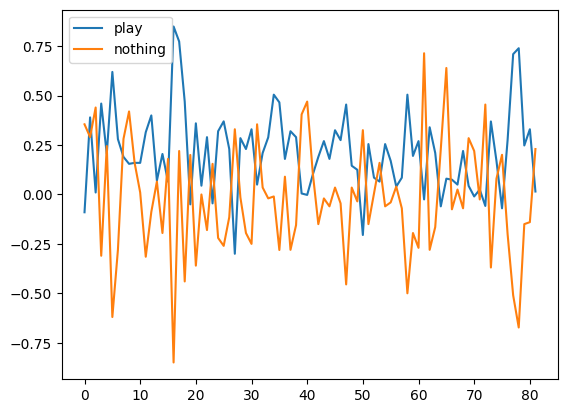Macy’s stock seasonality#
Background#
I noticed that in the last few years, Macy’s stock has been growing around the Thanksgiving season, which aligns with makes sense, since that’s where Americans buy their presents. I wanted to do a little more math than just eye-balling the chart. Below is an export from Jupyter Notebook that I used to analyze daily stock prices for Macy’s in the range from October to December from 2015 to 2023.
Imports & Constants#
import pandas
import matplotlib.pyplot as plt
# Inclusive range for dicing
YEARS = (2015, 2023)
MONTHS = (10, 12)
Download S&P 500 stock prices history as a CSV and parse the date#
# https://www.nasdaq.com/market-activity/index/spx/historical?page=102&rows_per_page=25&timeline=y10
spx = pandas.read_csv('60-SPX.csv')
spx = spx.reindex(index=spx.index[::-1])
spx = spx.reset_index(drop=True)
del spx['Open']
del spx['Close/Last']
spx['Year'] = spx['Date'].str.split('/', expand=True)[2].astype(int)
spx['Month'] = spx['Date'].str.split('/', expand=True)[0].astype(int)
spx['Day'] = spx['Date'].str.split('/', expand=True)[1].astype(int)
spx
| Date | High | Low | Year | Month | Day | |
|---|---|---|---|---|---|---|
| 0 | 08/26/2014 | 2005.04 | 1998.59 | 2014 | 8 | 26 |
| 1 | 08/27/2014 | 2002.14 | 1996.20 | 2014 | 8 | 27 |
| 2 | 08/28/2014 | 1998.55 | 1990.52 | 2014 | 8 | 28 |
| 3 | 08/29/2014 | 2003.38 | 1994.65 | 2014 | 8 | 29 |
| 4 | 09/01/2014 | 0.00 | 0.00 | 2014 | 9 | 1 |
| ... | ... | ... | ... | ... | ... | ... |
| 2523 | 08/19/2024 | 5608.30 | 5550.74 | 2024 | 8 | 19 |
| 2524 | 08/20/2024 | 5620.51 | 5585.50 | 2024 | 8 | 20 |
| 2525 | 08/21/2024 | 5632.68 | 5591.57 | 2024 | 8 | 21 |
| 2526 | 08/22/2024 | 5643.22 | 5560.95 | 2024 | 8 | 22 |
| 2527 | 08/23/2024 | 5641.82 | 5585.16 | 2024 | 8 | 23 |
2528 rows × 6 columns
Download the target stock (M) prices history and parse the date#
# https://finance.yahoo.com/quote/M/history/
prices = pandas.read_csv('60-M.csv')
del prices['Open']
del prices['Close']
del prices['Adj Close']
del prices['Volume']
prices['Year'] = prices['Date'].str.split('-', expand=True)[0].astype(int)
prices['Month'] = prices['Date'].str.split('-', expand=True)[1].astype(int)
prices['Day'] = prices['Date'].str.split('-', expand=True)[2].astype(int)
Merge the two datasets using date#
Discard any rows with incomplete data
df = pandas.merge(spx, prices, on=['Year', 'Month', 'Day'], how='inner', suffixes=('Spx', 'Stock'))
df = df[(YEARS[0] <= df.Year) & (df.Year <= YEARS[1]) & (MONTHS[0] <= df.Month) & (df.Month <= MONTHS[1])]
df['didx'] = [
d
for year in range(YEARS[0], YEARS[1] + 1)
for d in range((df.Year == year).sum())
]
df.describe()
| HighSpx | LowSpx | Year | Month | Day | HighStock | LowStock | didx | |
|---|---|---|---|---|---|---|---|---|
| count | 571.000000 | 571.000000 | 571.000000 | 571.000000 | 571.000000 | 571.000000 | 571.000000 | 571.000000 |
| mean | 3249.744991 | 3215.057180 | 2018.998249 | 10.984238 | 15.562172 | 25.290193 | 24.382172 | 31.224168 |
| std | 899.323476 | 888.901796 | 2.582328 | 0.821699 | 8.823070 | 11.689632 | 11.410891 | 18.331992 |
| min | 1927.210000 | 1893.700000 | 2015.000000 | 10.000000 | 1.000000 | 5.990000 | 5.570000 | 0.000000 |
| 25% | 2556.490000 | 2543.895000 | 2017.000000 | 10.000000 | 8.000000 | 15.915000 | 15.395000 | 15.000000 |
| 50% | 3098.200000 | 3083.260000 | 2019.000000 | 11.000000 | 15.000000 | 23.059999 | 22.040001 | 31.000000 |
| 75% | 3981.490000 | 3935.905000 | 2021.000000 | 12.000000 | 23.000000 | 35.070002 | 33.399999 | 47.000000 |
| max | 4808.930000 | 4780.980000 | 2023.000000 | 12.000000 | 31.000000 | 52.480000 | 51.209999 | 63.000000 |
Square up the data#
We want to plot several years on the same chart, so let’s trim the excess. For all the covered years find the smallest last day index.
years = list(range(min(df.Year), max(df.Year) + 1))
max_didx = min(max(df[df.Year==year].didx) for year in years)
min_didx = max(min(df[df.Year==year].didx) for year in years)
didxs = list(range(min_didx, max_didx + 1))
Plot#
The stock price deviations for the selected months range over the selected years.
The S&P index price for the same dates.
Stock price corrected to S&P index.
Note that we plot percentage changes of the stock from the first day of the season. On day one all prices are at 0%, and then for each year they deviate.
def convert_to_season(df, y, years, didxs):
base = dict(zip(df.Year[df.didx==0], y[df.didx==0]))
return pandas.DataFrame(
[
[
(y[(df.Year==year) & (df.didx==didx)].iloc[0] - base[year]) * 100 / base[year]
for year in years
]
for didx in didxs
],
columns=map(str, years)
)
stock_seasons = convert_to_season(df, df.LowStock, years, didxs)
spx_seasons = convert_to_season(df, df.LowSpx, years, didxs)
stock_seasons.plot()
spx_seasons.plot()
(stock_seasons - spx_seasons).plot();
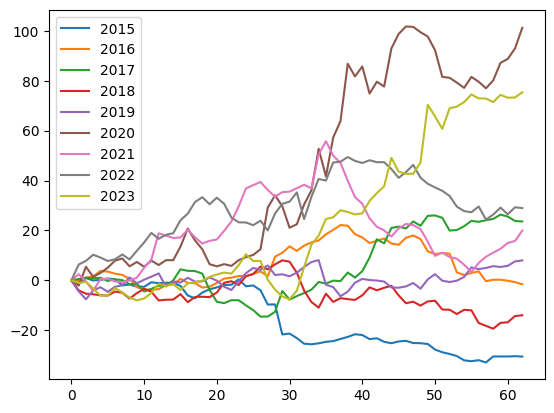
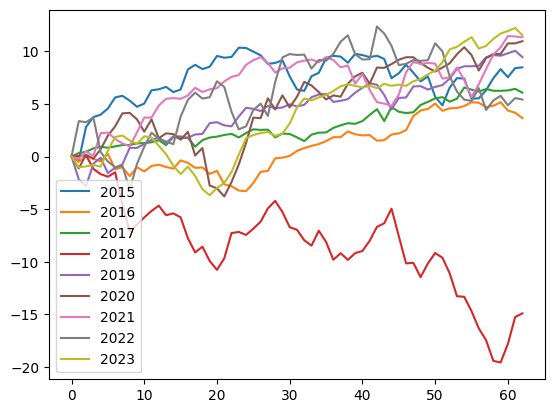
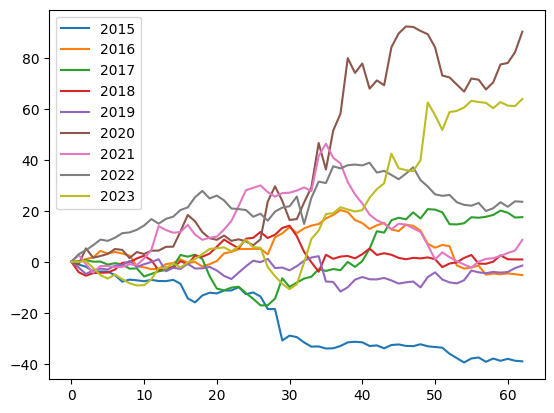
Download the M prices history with 1-minute precision#
# https://lime.co/market-data-source/#i5z6wk
prices = pandas.read_csv('60-M-1m.csv', delimiter=';')
for column in ('ticker', 'open', 'high', 'low', 'volume'):
del prices[column]
prices['Year'] = prices['date'].str.split('/', expand=True)[2].astype(int)
prices['Month'] = prices['date'].str.split('/', expand=True)[0].astype(int)
prices['Day'] = prices['date'].str.split('/', expand=True)[1].astype(int)
prices['Hour'] = prices['time'].str.split(':', expand=True)[0].astype(int)
prices['Minute'] = prices['time'].str.split(':', expand=True)[1].astype(int)
prices
| date | time | close | Year | Month | Day | Hour | Minute | |
|---|---|---|---|---|---|---|---|---|
| 0 | 7/1/2024 | 6:30:00 AM | 19.100 | 2024 | 7 | 1 | 6 | 30 |
| 1 | 7/1/2024 | 6:31:00 AM | 19.030 | 2024 | 7 | 1 | 6 | 31 |
| 2 | 7/1/2024 | 6:32:00 AM | 19.050 | 2024 | 7 | 1 | 6 | 32 |
| 3 | 7/1/2024 | 6:33:00 AM | 19.065 | 2024 | 7 | 1 | 6 | 33 |
| 4 | 7/1/2024 | 6:34:00 AM | 19.020 | 2024 | 7 | 1 | 6 | 34 |
| ... | ... | ... | ... | ... | ... | ... | ... | ... |
| 31726 | 10/24/2024 | 12:55:00 PM | 15.430 | 2024 | 10 | 24 | 12 | 55 |
| 31727 | 10/24/2024 | 12:56:00 PM | 15.450 | 2024 | 10 | 24 | 12 | 56 |
| 31728 | 10/24/2024 | 12:57:00 PM | 15.445 | 2024 | 10 | 24 | 12 | 57 |
| 31729 | 10/24/2024 | 12:58:00 PM | 15.445 | 2024 | 10 | 24 | 12 | 58 |
| 31730 | 10/24/2024 | 12:59:00 PM | 15.410 | 2024 | 10 | 24 | 12 | 59 |
31731 rows × 8 columns
Hypothesis 1#
When Macy’s stock spikes in the morning by at least 20c, it slides down in the evening by at least 10c.
def analyze_day(date: str, df: list[float]) -> tuple:
open_price = df[(df.Hour==6) & (df.Minute==30)].close.iloc[0]
morning_spike = max(df[df.Hour <= 6].close)
day_decline = min(df[(df.Hour >= 8) & (df.Hour <= 11)].close)
return open_price, morning_spike, day_decline, (morning_spike - open_price), (morning_spike - day_decline)
data = []
for date in set(prices['date']):
data.append([date, *analyze_day(date, prices[prices.date == date])])
# Spike-decline
sd = pandas.DataFrame(data, columns=('date', 'open_price', 'morning_spike', 'day_decline', 'spike', 'decline'))
len(sd[(sd.spike > 0.2)]), len(sd[(sd.spike > 0.2) & (sd.decline > 0.1)])
(14, 9)
sd[(sd.spike > 0.2) & (sd.decline > 0.1)][:5]
| date | open_price | morning_spike | day_decline | spike | decline | |
|---|---|---|---|---|---|---|
| 4 | 9/13/2024 | 14.760 | 15.160 | 14.8347 | 0.400 | 0.3253 |
| 7 | 8/6/2024 | 15.224 | 15.485 | 15.3800 | 0.261 | 0.1050 |
| 8 | 7/11/2024 | 19.130 | 19.470 | 19.2900 | 0.340 | 0.1800 |
| 17 | 7/5/2024 | 19.420 | 19.900 | 19.4800 | 0.480 | 0.4200 |
| 34 | 7/3/2024 | 17.940 | 18.180 | 17.9250 | 0.240 | 0.2550 |
import matplotlib.pyplot as plt
positive_days = sd[(sd.spike > 0.2) & (sd.decline > 0.1)]
negative_days = sd[(sd.spike > 0.2) & (sd.decline <= 0.1)]
def plot_samples(days, prices, count=5):
fig, axes = plt.subplots(nrows=count, ncols=1, figsize=(10, 10))
for i in range(count):
day = days.iloc[i]
date = day.date
prices[prices.date == date].close.plot(ax=axes[i])
axes[i].axhline(y=day.morning_spike, color='red', linestyle='--')
axes[i].axhline(y=day.day_decline, color='green', linestyle='--')
plot_samples(positive_days, prices)
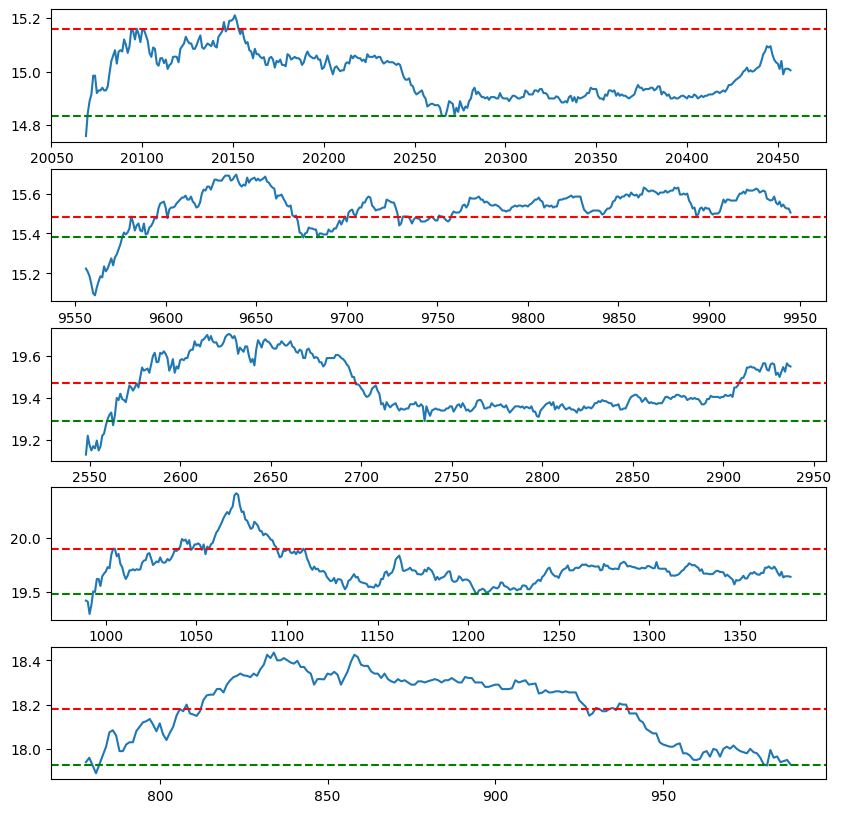
plot_samples(negative_days, prices)
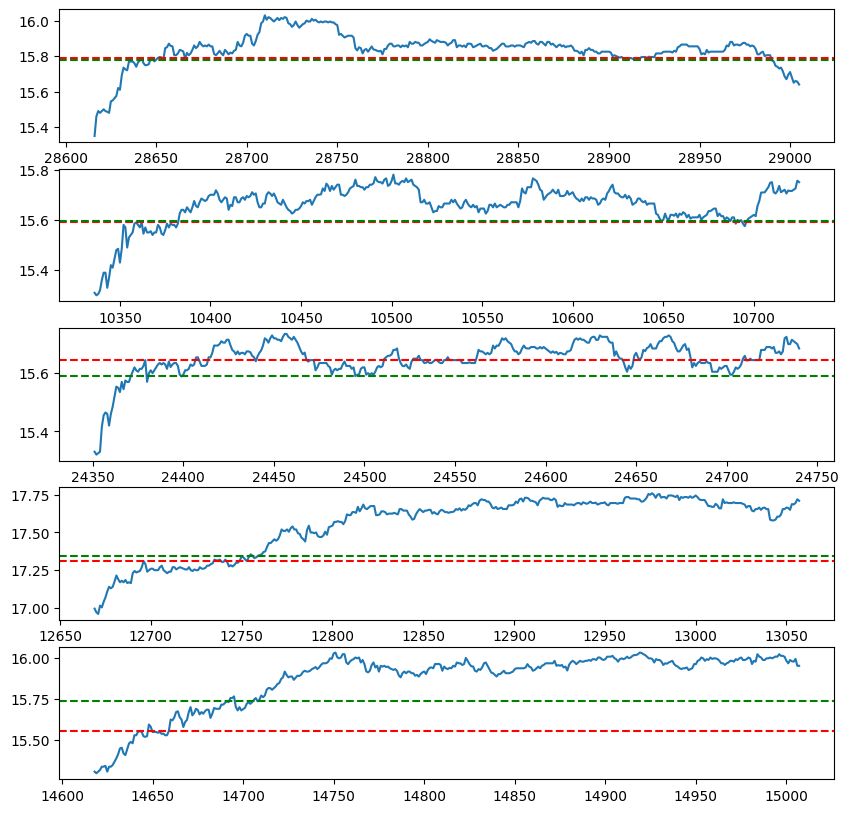
Hypothesis 2#
If you sell at high point before 11 AM, you can buy back by the end of day at least 10c lower price.
def analyze_day(date: str, df: list[float]) -> tuple:
prices = list(df.close)
open_price = prices[0]
high_price = max(df[df.Hour <= 8].close)
close_price = prices[-1]
open_delta = high_price - open_price
close_delta = high_price - close_price
day_delta = close_price - open_price
return [high_price - close_price, close_price - open_price]
data = []
for date in set(prices['date']):
data.append([date, *analyze_day(date, prices[prices.date == date])])
chart = pandas.DataFrame(data, columns=('date', 'play', 'nothing'))
chart.plot()
len(chart[chart.play - 0.2 > chart.nothing]) / len(chart)
0.524390243902439
